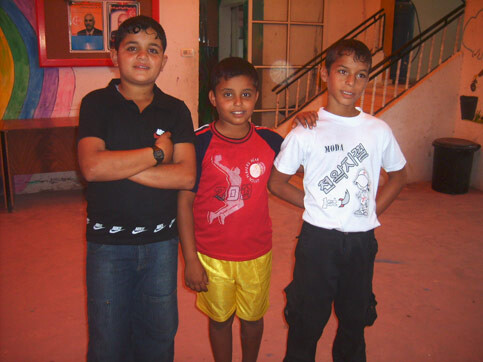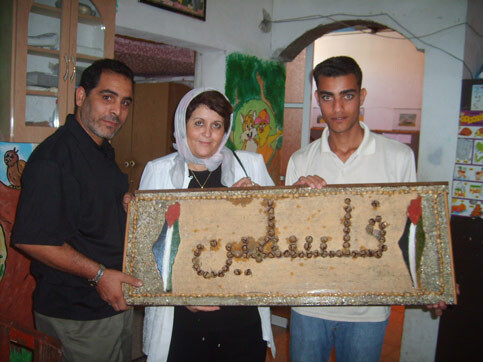Gaza Strip 17 December 2007

Three young boys from Nuseirat refugee camp say they consider Afaq Jadeeda Center their second home.
Today’s youth are tomorrow’s leaders. They don’t make the decisions today but will be shaped by ours and will in their turn shape successor generations. Now is our moment to influence not just the present but also the future. We won’t have a second chance. It is an urgent and awesome responsibility with the most profound and far-reaching consequences.
- John Ging, director of United Nations Relief and Works Agency’s (UNRWA) Gaza field office, to British parliament members, November 2007
In the dirty streets of the Nuseirat refugee camp in the Gaza Strip, the sparse fruit stands carry only rotten fruit, because it is all the market’s vendors can afford to sell, and all the refugees can afford to buy.
“It will still be gone in an hour,” says Dr. Mona El-Farra, “because they have to eat something.”
Of Gaza’s 1.5 million residents more than 60 percent are under 18. The effects of malnutrition are seen not only in the kids’ hunger, but also in their brain function. They are unable to focus in school, and have become violent. Dr. El-Farra’s organization, the Middle East Children’s Alliance (Gaza), is the focal point of a network of organizations trying to help Gaza’s children. They give food parcels to the families, which are aimed at the nutritional needs of the kids, and try to teach the parents how to feed them better.
“The lack [of food] here is all political, not from famine or drought,” says Dr. El-Farra. “The kids are not hopeful. There is no safety or recreation. It’s bad for everyone, but it is most profound when the kids are complaining and have no hope.”
Humanitarian groups in Gaza are also trying to feed another hunger: keeping the Palestinian culture alive through teaching traditional dancing, music, and art. The Afaq Jadeeda (New Horizons) Center in Nuseirat, established in 1996, provides a creative outlet for more than 50 children daily, and holds summer and winter camps. The center also has a library, a stage for plays, a football team and a growing computer lab, and is in the process of funding English classes for kids ages 14-18. $50,000 would give them what they need for a fully functioning center, but they do what they can with what they have, as they work on bringing in more donations and money.
“The average family in Gaza has seven people,” says Afaq Jadeeda vice president and schoolteacher Talal Abu Shawish. “In the refugee camps, families are trying to build up their own areas. That’s why it is important to have the cultural centers: to bring the kids off the streets into something more positive.”
But the problems are not only on the streets now; they are also in the schools.
“It’s not easy for teachers to control the kids,” says Abu Shawish. “There is violence at school — the kids toward each other — because of the bloody scenes they constantly see.”

From left, Talal Abu Shawish, Dr. Mona El-Farra, and Hany El Sharif, who started with the association as a child and now volunteers as an activities guide for the kids. The sign reads “Palestine” in Arabic.
To help the kids channel their anger into a more positive outlet, many of the schools have formed human rights and tolerance committees with elected parliaments made up of students and teachers. The committee at Abu Shawish’s school comprises eight teachers and 33 students and they concentrate on how to solve human rights issues with nonviolence. During their meetings, they define what the needs are at school and hold a workshop to come up with solutions, focusing on one human right per week. Students use scientific steps and written reports to present their ideas.
Most recently, he invited the school’s human rights team to Afaq Jadeeda, where they held a workshop to discuss how the association could help the students. What resulted, with help from Afaq and the Middle East Children’s Alliance headquarters in California, was a water purification system for the school that will provide healthy drinking water for 2,000 students. It is expected to be installed and functional by early December.
“The schools only have them for four hours a day, and the rest of the time they are exposed to their bloody society,” says Abu Shawish. “The parents should continue this at home, so we try to coordinate with them, and we bring the parents into the meetings, too, once a month.”
To help bring about this successful result, they organize trips to centers for human rights in the Gaza Strip. They also visit parliaments at other schools to discuss issues with them. He talks to other teachers about working human rights issues into their classes, and UNRWA visits him to see his plans.
The committee work is voluntary for him, he says, but necessary. These efforts are important, to combat the psychological effects of the occupation: “The Israelis mean to oppress the students. They form committees to make recommendations to the politicians on how to keep the society down, starting with the kids.”
But a shortage of psychological support makes it difficult to fight the damage that is being done.
“At each school, there is one counselor — a psychologist,” he points out. “1,000 students and only one counselor.”
So, again, he brings the community together to help, forming committees of teachers who have courses in guidance through UNRWA, and the committee coordinates with the counselor. They penalize problematic students and try to guide them to change their behavior. When they do, they give them awards. He also makes a list of kids who are emotionally and psychologically unhealthy and distributes it to the teachers and asks them to treat them nicer.
The organization tries to bring these practices to other areas of the society, so the nonviolent mindset is one they can carry with them through life: “We need to coordinate with other organizations to continue these practices, so they don’t leave and forget what we taught them.”
Sarah Price is a freelance journalist based in Los Angeles. She visited Gaza in October 2007, and has written for the South Florida Sun-Sentinel and KNBC Los Angeles, and has appeared on Lighthouse TV in Los Angeles, discussing the humanitarian crises in Gaza. All images by Sarah Price.
Related Links



